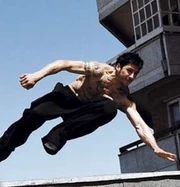
Hxc parkour preview season 3
see more videos on youtube: type in Peterkeo1

David Belle, depicted, is the founder of parkour.
Parkour (Le Parkour) (sometimes abbreviated as PK) is the l'art du déplacement[1], or "the art of displacement", and a global phenomenon that was developed in Lisses, a medium prosperous suburb of Paris, in the 1990s by David Belle.[2][1] It is an art of movement and philosophy in which one trains to overcome any obstacle, whether physical or mental, using only the body and mind.[3][4] A parkour practitioner, called a traceur (male) or traceuse (female), uses their surroundings to improve their ability to move through space three-dimentionally. By interacting with obstacles, be they urban architecture or the natural environment, the practitioner becomes more comfortable controlling the body and negotiating any type of terrain.[5]
It is worth noting that there are no specific "movements" of parkour, but there is no denying that there are certain movements that are used constantly when training for and practicing parkour. These movements do not constitute parkour itself, however; parkour is differentiated by the concept of movement, and the basic movements commonly associated with parkour are simply a means to that end.[6]
The bulk of parkour centers on enhancing the discipline of physical and technical training to heighten the body’s natural movement elements such as strength, speed, balance, coordination, accuracy, power, and endurance. It offers a full-body workout at any level of experience, and improves the ability to move, harness self-confidence, to change how one views the world.[3] A characteristic of parkour is efficiency. Traceurs move not only as rapidly as they can, but also in the most direct and efficient way possible. This is a characteristic that distinguishes it from the similar art of free running, which emphasizes more freedom of movement, such as incorporation of acrobatics.[7]
Parkour's application becomes apparent when circumstance necessitates it, such as being chased, or needing to reach a destination. Because parkour is composed of movements that are natural to humans, the body is strengthened evenly and synergistically, meaning all the parts of the body learn to work together. This helps to balance the body and improve all movement in general. Aside from the physical benefits, many people find training parkour develops mental clarity, confidence, self-discipline, the ability to deal with fear, and many other mental gains. [5]
History[]
The earliest form of parkour was developed by Georges Hebert, a French naval officer and philosopher of physical culture who served during the First and Second World Wars. As he served France, he also traveled, and he was impressed by the efficient, flowing gymnastic movements of some of the African tribes he visited. Upon returning to France, he began developing a method of natural movement for members of the military, in which men and women were encouraged to move efficiently and effectively around a wide variety of obstacles. The méthode naturelle (natural method)[3] began to be regularly taught, setting the stage for the development of parkour.[1]
Methode Naturelle was based on the idea that humans had ten essential movement capacities to walk, run, jump, climb, move on all fours, swim, balance, lift, throw, and engage in self-defense. One of the main methods Hebert proposed to train these capacities was obstacle courses. These obstacle courses, known as Parcours Du Combat, have become part of military training systems throughout the world. Part of Hebert’s philosophy was that physical training should strengthen one’s moral fabric. His motto was "Être fort pour être utile," ("be strong to be useful").[3]
Parkour began to be popularized in the 1990s, when several films were made about parkour.[1] Some traceurs have expressed concern over the mainstreaming of the sport, especially since parkour can be dangerous when it is practiced by untrained individuals. The art includes flying leaps, jumps, and other physically challenging moves which can look very showy, but also be hazardous.
Video Highlight[]

What is Parkour ??
What is Parkour?
This video offers a visual exploration of parkour highlights. Depicted are many of the common movements seen in parkour and some of the more technical movements reserved for elite traceurs.
Parkour in the Media[]
Films where parkour can be seen:
- Casino Royale - features Sébastien Foucan, an elite French traceur and pioneer
- Live Free or Die Hard
- District B13 - features founder, David Belle
- Jump London - a 2003 documentary
- Jump Britain - another parkour documentary
See Also[]
External Links[]
- American Parkour
- Parkour.com - Sébastien Foucan's site
- Parkour Generations
- Pacific Northwest Parkour Association - Seattle, Washington area parkour
- Urban Free Flow - parkour and free running
- Parkour Shoes Pro
Resources[]
- ↑ 1.0 1.1 1.2 1.3 unknown (n.d.). What is Parkour?. Wise Geeks. Retrieved on 2009-03-09.
- ↑ Alec Wilkinson (16 April 2007). No Obstacles. The New Yorker. Retrieved on 2009-03-11.
- ↑ 3.0 3.1 3.2 3.3 PNWPA (n.d.). What is Parkour?. Pacific Northwest Parkour Association. Retrieved on 2009-03-09.
- ↑ unknown (n.d.). What is Parkour?. Parkourpedia. Retrieved on 2009-03-11.
- ↑ 5.0 5.1 unk. (11 December 2005). What is Parkour?. American Parkour. Retrieved on 2009-03-09.
- ↑ unknown (n.d.). The Moves of Parkour. Parkourpedia. Retrieved on 2009-03-11.
- ↑ various (n.d.). Parkour. Wikipedia. Retrieved on 2009-03-11.